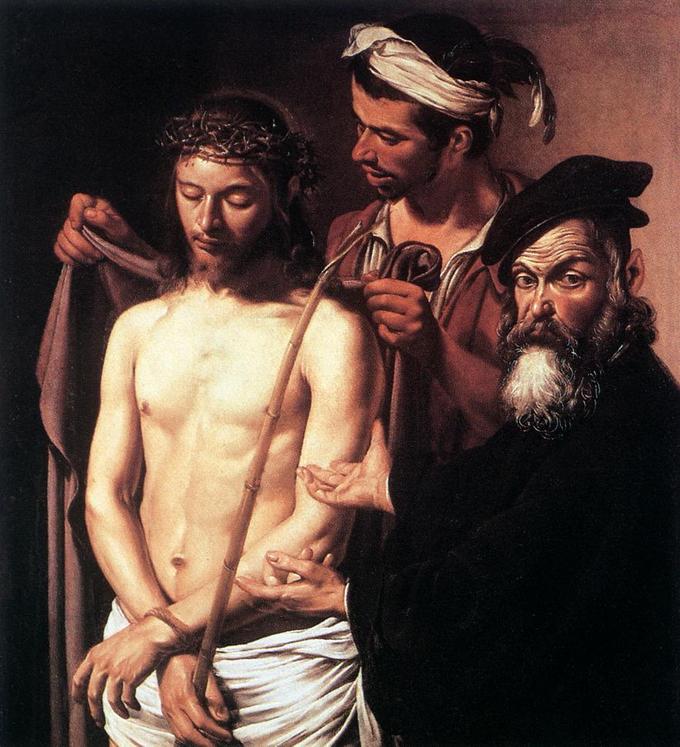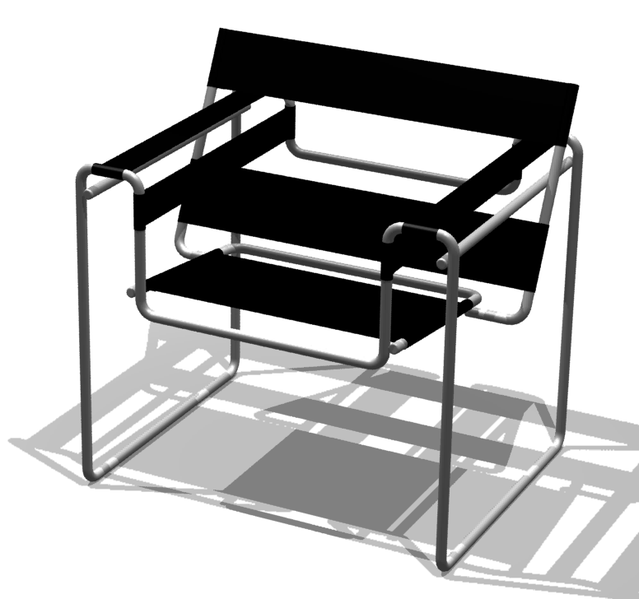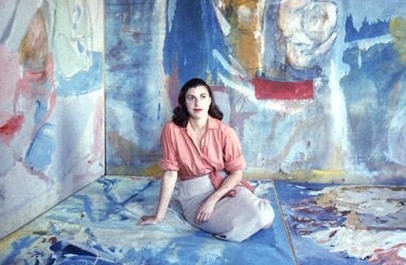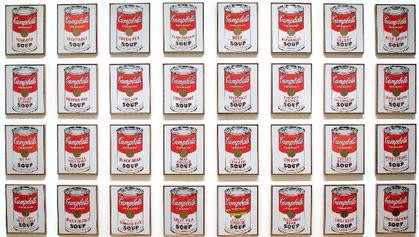Why Was Landscape Painting A Primary Vehicle For Expressing Artists' Feelings And Moods?
What is Art?
Interactions between the elements and principles of fine art help artists to organize sensorially pleasing works of fine art while as well giving viewers a framework within which to analyze and talk over aesthetic ideas.
Learning Objectives
Evaluate the frameworks we tin can use to analyze and discuss works of art
Central Takeaways
Key Points
- The coaction between the principles and elements of art provide a linguistic communication with which to discuss and analyze works of art.
- The principles of art include: movement, unity, harmony, variety, residue, contrast , proportion and pattern.
- The elements of art include: texture , form , space , shape, colour, value and line .
- How best to define the term art is a bailiwick of abiding contention.
- Since conceptual art and postmodern theory came into prominence, information technology has been proven that anything can be termed art.
Key Terms
- Formalism:The written report of fine art by analyzing and comparing form and style—the mode objects are fabricated and their purely visual aspects.
What is Art?
Art is a highly diverse range of human being activities engaged in creating visual, auditory, or performed artifacts— artworks—that express the writer'southward imaginative or technical skill, and are intended to exist appreciated for their beauty or emotional power.
The oldest documented forms of art are visual arts, which include images or objects in fields like painting, sculpture, printmaking , photography, and other visual media . Architecture is oft included as one of the visual arts; however, like the decorative arts, it involves the creation of objects where the practical considerations of use are essential, in a way that they usually are not in another visual art, like a painting.
Art may exist characterized in terms of mimesis (its representation of reality), expression, communication of emotion, or other qualities. Though the definition of what constitutes fine art is disputed and has changed over fourth dimension, general descriptions center on the idea of imaginative or technical skill stemming from human being agency and creation. When information technology comes to visually identifying a piece of work of art, there is no single gear up of values or artful traits. A Bizarre painting will not necessarily share much with a gimmicky performance piece, simply they are both considered fine art.
Despite the seemingly indefinable nature of art, there have always existed sure formal guidelines for its artful judgment and analysis. Formalism is a concept in art theory in which an artwork's artistic value is determined solely by its class, or how it is made. Formalism evaluates works on a purely visual level, because medium and compositional elements as opposed to whatever reference to realism , context, or content.
Art is often examined through the interaction of the principles and elements of art. The principles of art include movement, unity, harmony, variety, rest, dissimilarity, proportion and pattern. The elements include texture, form, infinite, shape, color, value and line. The various interactions betwixt the elements and principles of art help artists to organize sensorially pleasing works of fine art while also giving viewers a framework within which to clarify and talk over artful ideas.

Ecce Man, Caravaggio, 1605: This is an instance of a Baroque painting.
What Does Art Practice?
A key purpose inherent to most artistic disciplines is the underlying intention to appeal to, and connect with, human emotion.
Learning Objectives
Examine the communication, utilitarian, aesthetic, therapeutic, and intellectual purposes of art
Key Takeaways
Key Points
- The decorative arts add aesthetic and design values to the objects we use every day, such as a glass or a chair.
- Art therapy is a relatively young type of therapy that focuses on the therapeutic benefits of fine art-making, using dissimilar methods and theories.
- Since the introduction of conceptual art and postmodern theory, it has been proven that annihilation can, in fact, be termed art.
- Information technology can be said that the fine arts represent an exploration of the human condition and the attempt at a deeper understanding of life.
Key Terms
- human status:The characteristics, key events, and situations which etch the essentials of human existence, such as birth, growth, emotionality, aspiration, conflict, and mortality.
- fine arts:Visual fine art created principally for its aesthetic value.
- aesthetic:Concerned with artistic bear on or appearance.
A fundamental purpose mutual to nigh art forms is the underlying intention to appeal to, and connect with, homo emotion. However, the term is incredibly broad and is broken up into numerous sub-categories that lead to commonsensical , decorative, therapeutic, communicative, and intellectual ends. In its broadest grade, fine art may be considered an exploration of the homo condition, or a production of the human experience.
The decorative arts add together aesthetic and design values to everyday objects, such equally a glass or a chair, transforming them from a mere commonsensical object to something aesthetically beautiful. Entire schools of thought be based on the concepts of design theory intended for the physical earth.

Bauhaus chair past Marcel Breuer: The decorative arts add artful and pattern values to everyday objects.
Fine art can office therapeutically besides, an idea that is explored in art therapy. While definitions and practices vary, art therapy is generally understood equally a form of therapy that uses art media as its primary way of communication. It is a relatively young subject field, starting time introduced around the mid-20th century.
Historically, the fine arts were meant to appeal to the human intellect, though currently in that location are no truthful boundaries. Typically, art movements have reacted to each other both intellectually and aesthetically throughout the ages. With the introduction of conceptual fine art and postmodern theory, practically annihilation can exist termed art. In general terms, the fine arts represent an exploration of the human condition and the attempt to experience a deeper understanding of life.
What Does Fine art Mean?
The meaning of fine art is shaped by the intentions of the creative person as well as the feelings and ideas it engenders in the viewer.
Learning Objectives
Evaluate the perspectives backside the meaning of fine art
Key Takeaways
Key Points
- The meaning of fine art is oftentimes shared among the members of a given society and dependent upon cultural context.
- The nature of art has been described past philosopher Richard Wollheim every bit "ane of the most elusive of the traditional issues of human civilisation."
- Some purposes of fine art may be to limited or communicate emotions and ideas, to explore and appreciate formal elements for their ain sake, or to serve as representation.
- Art, at its simplest, is a class of advice and means any it is intended to mean by the artist.
Key Terms
- mimesis:The representation of aspects of the real globe, especially human deportment, in literature and art.
The pregnant of art is often culturally specific, shared amongst the members of a given gild and dependent upon cultural context. The purpose of works of art may be to communicate political, spiritual or philosophical ideas, to create a sense of dazzler (meet aesthetics), to explore the nature of perception, for pleasure, or to generate strong emotions. Its purpose may also exist seemingly nonexistent.
The nature of fine art has been described by philosopher Richard Wollheim as "one of the most elusive of the traditional problems of human civilization." Information technology has been defined as a vehicle for the expression or communication of emotions and ideas, a means for exploring and appreciating formal elements for their ain sake, and as mimesis or representation. More recently, thinkers influenced by Martin Heidegger have interpreted art as the means past which a community develops for itself a medium for cocky-expression and interpretation.

Helen Frankenthaler, 1956: A photo of the American artist Helen Frankenthaler in her studio in 1956.
Fine art, in its broadest sense, is a form of communication. Information technology means whatever the artist intends it to hateful, and this significant is shaped by the materials, techniques, and forms it makes use of, as well equally the ideas and feelings it creates in its viewers . Fine art is an act of expressing feelings, thoughts, and observations.
What Makes Fine art Beautiful?
Dazzler in terms of art refers to an interaction betwixt line, color, texture, sound, shape, motion, and size that is pleasing to the senses.
Learning Objectives
Define "aesthetics" and "beauty" as they relate to art
Key Takeaways
Key Points
- Beauty in fine art tin can be difficult to put into words due to a seeming lack of accurate language.
- An artful judgment cannot be an empirical judgment only must instead be candy on a more intuitive level.
- Aesthetics is the co-operative of philosophy that deals with the nature and appreciation of art, beauty, and taste. Aesthetics is primal to any exploration of fine art.
- For Immanuel Kant, the artful experience of beauty is a judgment of a subjective, just common, human truth.
- For Arthur Schopenhauer, artful contemplation of beauty is the freest and about pure and truthful that intellect can be, and is therefore beautiful.
- Fine art is oftentimes intended to appeal to, and connect with, man emotion.
Central Terms
- aesthetics:The co-operative of philosophy dealing with the nature of art, taste, and the creation and appreciation of dazzler.
- intuitive:Spontaneous, without requiring conscious idea; easily understood or grasped by instinct.
What makes art beautiful is a complicated concept, since beauty is subjective and can modify based on context. However, there is a basic homo instinct, or internal appreciation, for harmony, balance, and rhythm which can be defined as beauty. Dazzler in terms of art usually refers to an interaction between line, colour, texture , sound, shape, motility, and size that is pleasing to the senses.
Artful Art
Aesthetics is the co-operative of philosophy that deals with the nature and appreciation of fine art, beauty, and taste. Aesthetics is central to any exploration of art. The give-and-take "aesthetic" is derived from the Greek "aisthetikos," significant "esthetic, sensitive, or sentient. " In practise, aesthetic judgment refers to the sensory contemplation or appreciation of an object (not necessarily a piece of work of art), while artistic judgment refers to the recognition, appreciation, or criticism of a work of fine art.
Numerous philosophers take attempted to tackle the concept of beauty and fine art. For Immanuel Kant, the aesthetic experience of dazzler is a judgment of a subjective, but mutual, man truth. He argued that all people should agree that a rose is beautiful if information technology indeed is. There are many common conceptions of beauty; for instance, Michelangelo's paintings in the Sistine Chapel are widely recognized every bit beautiful works of art. However, Kant believes beauty cannot exist reduced to any basic set up of characteristics or features.
For Arthur Schopenhauer, aesthetic contemplation of dazzler is the freest and virtually pure that intellect can be. He believes that merely in terms of aesthetics do we contemplate perfection of class without any kind of worldly agenda.

Michelangelo, The Cosmos of Adam, The Sistine Chapel, 1508-1512:
Beauty in fine art can be difficult to put into words due to a seeming lack of accurate language. An aesthetic judgment cannot be an empirical judgment but must instead be processed on a more intuitive level.
Art and Human Emotion
Sometimes beauty is non the creative person'southward ultimate goal. Fine art is oft intended to appeal to, and connect with, human being emotion. Artists may express something and then that their audition is stimulated in some way—creating feelings, religious faith, curiosity, interest, identification with a group, memories, thoughts, or inventiveness. For example, operation art often does not aim to please the audition but instead evokes feelings, reactions, conversations, or questions from the viewer . In these cases, aesthetics may be an irrelevant measure out of "cute" art.
Who Is an Artist?
An artist is a person who is involved in the wide range of activities that are related to creating art.
Learning Objectives
Summarize the evolution of the term "creative person" and its predecessors
Key Takeaways
Primal Points
- In ancient Greece and Rome there was no word for "artist," just there were nine muses who oversaw a different field of human creation related to music and poetry, with no muse for visual arts.
- During the Middle Ages , the word "artista" referred to something resembling "craftsman."
- The first sectionalisation into major and minor arts dates dorsum to the 1400s with the piece of work of Leon Battista Alberti.
- The European Academies of the 16th century formally solidified the gap between the fine and the applied arts which exists in varying degrees to this twenty-four hours.
- Currently an artist can be divers as anyone who calls him/herself an artist.
Key Terms
- muses:Goddesses of the inspiration of literature, scientific discipline, and the arts in Greek mythology.
- Popular art:An fine art movement that emerged in the 1950s that presented a challenge to traditions of fine art by including imagery from popular civilisation such as advertising and news.
- fine arts:The purely aesthetic arts, such as music, painting, and poetry, equally opposed to industrial or functional arts such equally engineering or carpentry.
An artist is a person who is involved in the wide range of activities that are related to creating art. The word has transformed over time and context, merely the modernistic understanding of the term denotes that, ultimately, an artist is anyone who calls him/herself an artist.
In ancient Hellenic republic and Rome, there was no word for "artist." The Greek word "techne" is the closest that exists to "fine art" and ways "mastery of any art or arts and crafts." From the Latin "tecnicus" derives the English words "technique," "engineering," and "technical." From these words we can denote the aboriginal standard of equating art with manual labor or craft.
Each of the 9 muses of aboriginal Greece oversaw a different field of human being creation. The creation of poetry and music was considered to be divinely inspired and was therefore held in high esteem. Withal, there was no muse identified with the painting and sculpture; ancient Greek culture held these art forms in depression social regard, because work of this sort to exist more than forth the lines of manual labor.
During the Middle Ages, the word "artista" referred to something resembling "craftsman," or student of the arts. The commencement sectionalisation into "major" and "small-scale" arts dates back to the 1400s with the piece of work of Leon Battista Alberti, which focused on the importance of the intellectual skills of the artist rather than the manual skills of a craftsman. The European academies of the 16th century formally solidified the gap betwixt the fine and the applied arts, which exists in varying degrees to this day. More often than not speaking, the practical arts use design and aesthetics to objects of everyday employ, while the fine arts serve equally intellectual stimulation.
Currently, the term "artist" typically refers to anyone who is engaged in an action that is deemed to be an art class. However, the questions of what is art and who is an artist are non hands answered. The idea of defining art today is far more than difficult than it has e'er been. After the exhibition during the Pop Art movement of Andy Warhol'southward Brillo Box and Campbell'due south Soup Cans, the questions of "what is fine art?" and "who is an artist?" entered a more conceptual realm. Anything can, in fact, be art, and the term remains constantly evolving.

Andy Warhol, Campbell's Soup Cans, 1962: Andy Warhol'due south Campbell'south Soup Cans have come to be representative of the Popular Art movement.
Licenses and Attributions
Source: https://www.coursehero.com/study-guides/boundless-arthistory/what-is-art/
Posted by: ramseyslin1985.blogspot.com

0 Response to "Why Was Landscape Painting A Primary Vehicle For Expressing Artists' Feelings And Moods?"
Post a Comment